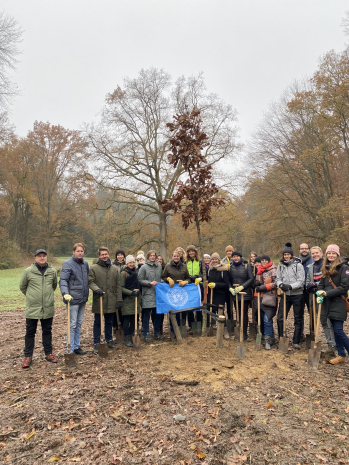UN and EU Staff Plant over 600 Trees in Arboretum of Tervuren
Discussion details
On Friday 9 December, the day before Human Rights Day, some 30 staff from UN offices in Brussels and the European Commission planted more than 600 trees in the Arboretum of Tervuren, to mark the right to a healthy environment which was recognized in July by the UN General Assembly.
The UNEP Brussels Office and the UN Regional Information Centre (UNRIC), had organized this activity in collaboration with UN Human Rights (OHCHR), UN Food and Agriculture Organization (FAO), and foresters from the Arboretum of Tervuren.
Through the tree planting in the Arboretum of Tervuren which is situated in the South East of Brussels, the organizers also sought to highlight the impact of climate change on forests, and emphasise the importance of the UN Biodiversity COP15.
While many of the trees which the staff planted were part of a restoration exercise of existing species such as spruces, elms and firs, they also planted some new variants as part of the arboretum’s plans to grow species that are better adaptive to the effects of climate change.
The Arboretum of Tervuren boasts a collection of more than 30.000 trees and shrubs, and includes over 600 tree species, of which many rare and threatened ones. Extreme weather conditions, such as long-term droughts and heavy rainfalls, as well as other threats, like the rise of new parasites, have caused the loss of hundreds of these trees. Hence, the need to restore many of the trees, but also explore the introduction of new species.

The event started with a special tree planting ceremony in the memory of late Director General of DG for Climate Action of the European Commission, Mauro Petriccione.
In the middle of a meadow, Ms Veronika Hunt Safrankova, Head of UNEP Brussels Office and Ms Florika Fink-Hooijer, Director General of the European Commission’s Directorate General for the Environment, initiated the planting of a Sessile oak (Quercus petraea) which replaced a big tree that died.
"These trees are an essential part of the meadow ecosystem," Kevin Knevels, Forest Manager of the Arboretum of Tervuren explained. “We chose a Sessile oak instead of the Common oak (Quercus robur) as they are better suited for the changing climate.”
In her opening remarks, Florika Fink-Hooijer, Director General of DG Environment of the European Commission, expressed gratitude to the UN family in Brussels for maintaining a close partnership with DG Environment of the European Commission, also on the annual “#ForOurPlanet(link is external)” campaign, which aims at raising awareness around nature and biodiversity protection through events and digital action.
Ms Fink-Hooijer emphasised the importance and symbolism of trees for addressing climate change and biodiversity loss, and pointed to the international negotiations around drought, climate and biodiversity (COP15 of the UN Convention to Combat Desertification, the UN Climate COP27, the ongoing UN Biodiversity COP15): “All of the three COPs are interlinked. It is all about one system and that system doesn’t work anymore. (…) I think it is a very appropriate moment to do the tree planting now, just before COP15. It is like planting a seed, not just for the next COP but for the years to come.”

Ms Hunt Safrankova, who spoke on behalf of the UN, explained the symbolism of the tree planting exercise in support of the right to a healthy environment. She also underlined that by this team effort we want to encourage local actions to restore nature within the spirit of the UN Decade on Ecosystem Restoration, that ends in 2030.
Contributing locally to restore nature is a way we all can help influence the well-being our planet. You can find out more about UNEP’s work on forests on our website.(link is external)
About the Geographic Arboretum of Tervuren
Situated in the municipality of Tervuren in the outskirts of Brussels, the Geographic Arboretum sits like a crown on the head of the majestic Sonian Forest. Countless trees and shrubs from the North, the West and the East of North America, from Central and Mediterranean Europe, from the Middle and Far East of Asia are grouped here by region of origin in some hundred sections, covering a total of 120 ha.
The arboretum was founded in 1902 on a property of King Leopold II and is today the most attractive public domain of the patrimony bequeathed by the king to the Belgian nation in 1903.
Read more about the event here.
For more information see: https://arboretum-tervuren.be/(link is external)
Log in with your EU Login account to post or comment on the platform.